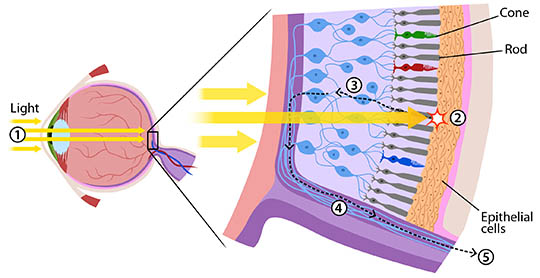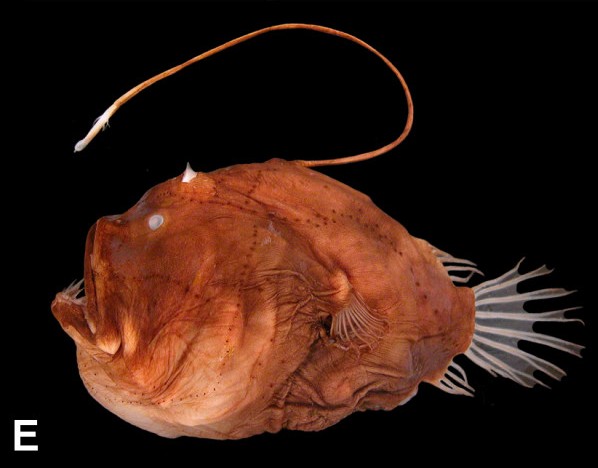Or do they? Because what could be also said that these people disregard things as they are now, i.e don't see the reality as it is now. And what is actually better or right?
I've been going back and forth on this one...
I think maybe the best would be the most objective: to see the colors as they are in the photo (grey/teal), but to also be able to infer that the actual colors of the shoes are pink and white. But that's just a hunch!
I was thinking the same. To see the illusion for what it IS, but also beyond the illusion, the "unseen", so to spreak.
All this color business has also made be wonder about how deep sea marine life still have and see colors and patterns in an environment with particularly very little to no natural light. Well lets see if mother nature has any insights for us? For instance check out these two articles:
If you have ever walked into a pitch-dark room, you know that your eyes take a few minutes to adjust. You are barely able to make out shapes and have to feel your way around. Now imagine fishes that live in the deepest, darkest parts of our oceans where hardly any light filters through. Not only...

youngzine.org
How Deep Sea Fish See In The Dark
May 18, 2019 By
Deepa Gopal
Image credit WIkipedia/CC
If you have ever walked into a pitch-dark room, you know that your eyes take a few minutes to adjust. You are barely able to make out shapes and have to feel your way around.
Now imagine fishes that live in the deepest, darkest parts of our oceans where hardly any light filters through.
Not only do they have to search for food, but also avoid becoming prey.
A recent study has shown that some species of deep sea fish might, in fact, be endowed with color vision, and able to recognize other bioluminescent creatures that live in our ocean's Twilight Zones!
How did these fishes that have never seen light develop the ability to see?
How We See Color
Let's begin with a look at how our human eyes perceive color.
Image credit askabiologist.asu.edu
When the light that is reflected off of objects (such as a lemon) enters our eyes, it hits a region known as the retina. Here it activates certain photoreceptor cells called cones and rods. Cones play a part under bright-light conditions and help us recognize color, while rods help us recognize shapes in low light conditions.
While we have about 120 million rods, there are 6 to 7 million cones in just 0.3-millimeter area of our retina! Of these cone cells, 64% respond to red light, 32% to green light and 2% to blue light. The yellow color wavelength from the lemon triggers different combinations of cone cells, which send electrical messages to our brains via the optic nerve. Our brain decodes these impulses and detects the color yellow.
Both rods and cones contain proteins known as opsins. While cones in human eyes have three kinds of opsins (called photopsin), rods only have one opsin known as rhodopsin.
Eyesight In Deep Sea Fish
A bioluminescent anglerfish; Image credit
Wikipedia/CC
Researchers noticed that deep sea fish actually lack the genes needed to create cones. Surprisingly, their rod cells had evolved and produced several opsins that helped them distinguish color in the dark!
Of the more than 100 species of deep sea fish that were analyzed, three species were found to have several rod opsins. The discovery of 38 rod opsins in the silver spiny fish astounded scientists.
They believe that rods evolved to capture faint daylight as well as the blue and green colors of bioluminescent creatures found at these vast depths.
Scientists did not test the eyesight of these fishes directly. That's because deep sea fishes have evolved to withstand the extreme pressure, coldness, and darkness found a mile below the ocean surface. Bringing these fish out of their environment would simply kill them. To test their theory, scientists injected the silver spiny fish's genes into bacteria and generated rod opsins that they then tested in the lab for sensitivity to light.
Fascinating how much we are still learning about this magical world around us, isn't it!
And this one about why most deep sea fish are red in color:
Red light does not reach ocean depths, so deep-sea animals that are red actually appear black and thus are less visible to predators and prey.

oceanexplorer.noaa.gov
Why are so many deep-sea animals red in color?
Red light does not reach ocean depths, so deep-sea animals that are red actually appear black and thus are less visible to predators and prey.
[...]
Sunlight contains all of the colors of our visible spectrum; these colors combined together appear white. Red light has the longest wavelength and, therefore, the least amount of energy in the visible spectrum. Wavelength decreases and energy increases as you move from red to violet light across the spectrum in the following order: red, orange, yellow, green, blue, and violet.
As light wavelength decreases from red to blue light, so does the ability of light to penetrate water. Blue light penetrates best, green light is second, yellow light is third, followed by orange light and red light. Red light is quickly filtered from water as depth increases and red light effectively never reaches the deep ocean.
Color is due to the reflection of different wavelengths of visible light. When white light (containing all colors on the spectrum) strikes an object, some wavelengths are absorbed; wavelengths that are not absorbed reflect back to our eyes. That is what we perceive as the color of that object. When struck by white light, a red fish at the surface reflects red light and absorbs all other colors and thus appears red. However, the deeper you and the fish go, the less red the fish will appear, because there is less and less red light to reflect off of the fish. At 100 meters, red light does not penetrate and, at this depth, a red fish is difficult, if not impossible to see. Instead, the fish appears blackish because there is no red light to reflect at that depth, and the fish absorbs all other wavelengths of color.
In the twilight zone, there are numerous animals that are black or red. At depth, these animals are not visible. The black animals absorb all colors of light available and the red animals appear black as well since there is no red light to reflect and their bodies absorb all other available wavelengths of light. Thus, in the deep ocean, red and black animals predominate.
Since the color blue penetrates best in water, there simply are not that many blue animals in the midwater regions of the ocean – their entire bodies would reflect the blue light and they would be highly visible to predators.
So where am I going with all this? Well lets see if I can figure it out, or at least try to

I was wondering about what Keit said, that the monitor is like "reality "separating"/"one step removed" factor. And some people are able to disregard this separation and see it as it would appear in reality, and some see it just like it is on the screen."
So If the monitor is absorbing some level of red light (pink being a pale shade of red) to create the illusion that shoes are grey to apparently most people so far, just like how it is in the darkness of the deep sea that red is the predominant color of marine life due to red light not being to penetrate such great water depths and thus both predator and prey have "intelligently selected" this color so as to appear as black, is the monitor kind of like acting like a water filter to the red light? It is interesting that the shoe laces that are supposed to be white appear to most as aquamarine (something close to this shade of blue), and blue according to the article above, is supposed to be the one color that best penetrates in water.
So the monitor hypotheses playing some sort of "reality "separating"/"one step removed" function that is similar in a way to filtering/absorbing of the red light out of the white light but not the blue light in the great depths of the ocean, making the pink of the shoe appear grey and the white appear aquamarine/etc., and how some people bypass this hypothesized filter, well, I am not too certain. I would speculate on what others have mentioned already about some people perhaps having a 4th cone in the eyes (Tetrachromacy) that enables them to be more sensitive to seeing reds and whites even through such "filters" like our devices' screens. Hmm, although I think, and feel it a bit in the gut, that I am definitely missing many things in this speculation, things having to do with one's level of Knowledge and Awareness gradually changing one's machine to be able to see both the real colors and the illusion of the colors through the "filter" at the same time in reality; similar perhaps to what Approaching Infinity also speculated above, I think. Perhaps working towards the balance of the right and left brain hemispheres would allow for such a perceptual capability to blossom?
Well it is just speculation at this point, but yeah, those of you who might hypothetically already have this speculated ability, well I have one thing to say to you unseen fellows:

But at the same time, thank you for honouring our Free Will and throwing us some "food for thought" here and there to get the networking juices flowing.

Anyways, so I guess, for those very few who mentioned that they saw the actual pink and white colors of the shoes behind their monitors/phone screens, and for those who the next day or less saw the actual colors as well when they originally saw grey/beige and light blue/etc, and for those who like myself still see the same thing more or less as originally mentioned, well if we were present in the same lighting environment as the shoes, would be all see the same colors? The pink and the white? I currently think perhaps so, but some faster than others maybe, since our eyes/brains would have an easier time to adjust in the actual environment to the lights then through a device's screen, or so I think.
One last thing I recall in the sessions having to do with the color blue and beyond the color blue in the color spectrum:
May 31, 1995
Frank, Laura, SV
[...]
(L) Our ability to see or perceive, blue, according to some researchers, is very recent. Natives who live on the Blue Nile describe it as brown, Homer described the Mediterranean as the "Wine dark sea," and Aristotle said there were only three colors in the rainbow: red, yellow and green. Is this true, that the human race, in general, has only recently become able to see blue?
A: Yes.
Q: (L) Is this a reflection of the spirituality of the color blue?
A: Yes.
Q: (L) Obviously there are colors beyond blue, and as we attain greater spirituality, we will be able to see them as well, is this true?
A: Yes.
Q: (SV) When you look at a rainbow you can see a shimmer or haze on either side. (L) Could it be that as a result of constant straining to see at higher frequencies, some people's eyes suffer?
A: Maybe.
Q: (L) Could this be a problem with people in spiritual or personal development?
A: Maybe.
Hmm, and blue light penetrates the farthest in the deep sea and our eyes have the least cones for blue light, only 2% "out of 6 to 7 million cones in just 0.3-millimete area of our retina" according to the first article above. Well if what the C's said above in the bold is true, that having the least blue cones kind of make sense and I guess we "get" more through spiritual or personal development? Then there was what RA mentioned about the blue spectrum, as I recall another forum member shared quotes of back in
2014. Here are the quotes he shared that I found interesting reading for the first time maybe a 3-4 weeks ago, roughly:
Session 33
RA: The violet ray of the positive fourth-density will be tinged with the green, blue, indigo triad of energies. This tinge may be seen as a portion of a rainbow or prism, as you know it, the rays being quite distinct.
The violet ray of fourth-density negative has in its aura, shall we say, the tinge of red, orange, yellow, these rays being muddied rather than distinct.
Session 34
RA: The indigo ray, though precious, is that ray worked upon only by the adept, as you would call it. It is the gateway to intelligent infinity bringing intelligent energy through. This is the energy center worked upon in those teachings considered inner, hidden and occult, for this ray is that which is infinite in its possibilities. As you are aware, those who heal, teach, and work for the Creator in any way which may be seen to be both radiant and balanced are those activities which are indigo ray.
Session 47
RA: The indigo-ray body which we choose to call the etheric body is, as we have said, the gateway body. In this body form is substance and you may only see this body as that of light as it may mold itself as it desires.
RA: The indigo-ray body may be used by the healer once the healer becomes able to place its consciousness in this etheric state.
RA: The first body which activates itself upon death is the “form-maker” or the indigo-ray body. This body remains—you have called it the “ka”—until etherea has been penetrated and understanding has been gained by the mind/body/spirit totality. Once this is achieved, if the proper body to be activated is green-ray, then this will occur.
RA: The normal procedure, given an harmonious passage from yellow-ray bodily manifestation, is for the mind and spirit complex to rest in the etheric or indigo body until such time as the entity begins its preparation for experience in an incarnated place which has a manifestation formed by the etheric energy molding it into activation and manifestation. This indigo body, being intelligent energy, is able to offer the newly dead, as you would term it, soul a perspective and a place from which to view the experience most recently manifested. Is there a short query we may answer at this time?
Session 54
RA: The positively oriented entity will be transmuting strong red-ray sexual energy into green-ray energy transfers and radiation in blue and indigo and will be similarly transmuting selfhood and place in society into energy transfer situations in which the entity may merge with and serve others and then, finally, radiate unto others without expecting any transfer in return.
So maybe this speculation about balance of the left and right brain thingy helping to see past the "filter" is not such a wild speculation?









 But at the same time, thank you for honouring our Free Will and throwing us some "food for thought" here and there to get the networking juices flowing.
But at the same time, thank you for honouring our Free Will and throwing us some "food for thought" here and there to get the networking juices flowing. 


